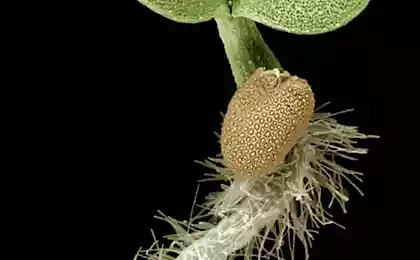1127
Feelings of plants— what and how they see
Fifty two million seven hundred forty one thousand four hundred fifty one
This is a translation of chapters from the book of Daniel Samovila "What a plant knows" that will help us to better understand plants.
"It turns out that a number of us, under our noses, there is a world which is not thought of any, even the most inventive science fiction writer. The world of immortal creatures that move without muscles "eat" sunshine, I think not the brain, "nervous" without a nervous system, and even the whole body with different age."
Tsymbal V. A. Plant. Parallel world
Just imagine: plants can see you! Plants can see when you approach them, they know when you're standing over them. They even know whether you wear blue or red shirt. They know the colors of your home or realize that their pot to be moved from one room to the other. Of course, they see us. Plants can not tell a bald middle-aged man with glasses from girls with chestnut curls. But they do see light in many respects more diverse than we are. Plants can see the UV light that gives us sunburn and infrared light, which we feel as heat. Plants know about light around — whether it's the light from a candle or the midday sun. Plants know where the light source is left, right or top. They understand that other plant, raised above, has stood in their light. Can this be considered a "vision"?
The Merriam-Webster dictionary defines "vision" as "physical feeling at which light stimuli received by the receptors of the eye are interpreted by the brain and formed the idea of the position, shape, brightness and color of objects in space". We see the light of the so-called "visible spectrum". The clear light is synonymous with electromagnetic waves of the visible spectrum. I.e., the light has properties common to other types of electrical signals such as micro - and radio waves. Radio waves for AM radio very long, nearly half a mile in length. Whereas x-ray waves are very short, one trillion times smaller than radio waves, which is why they so easily pass through our body. Light waves are somewhere in the middle: between 0,0000004 and 0,0000007 M. Blue light is the shortest, while red is the longest, green, yellow and orange in the middle (remember the rainbow). We see these electromagnetic waves because our eyes have special proteins called photoreceptors that know how to take that energy, absorb it, similarly, the antenna catches the radio waves. The retina of our eye is covered with rows of these receptors, like the rows of light-emitting diodes (LED) flat screen televisions or sensors in digital cameras. Each point of the retina has photoreceptors sticks, which are sensitive to light, and cones that respond to color. The human retina contains about 125 million rods and 6 million cones in the area, similar in size to the photograph on the passport. This is equivalent digital camera with a resolution of 130 megapixels. Such a huge number of photoreceptors in such a small area gives us a high definition image. Coli, sensitive to light allow us to see at night in low light conditions. Cones allow us to see different colours in bright light, also they are of three types, which differ in the perceived light the red, green and blue. The main difference between these photoreceptors — the chemicals contained in them. These substances are called rodopsin (in the sticks) and photopsia (in cones) have a certain structure, which allows them to absorb light with different wavelengths. Blue light is absorbed by rhodopsin and the blue photopsin, red — rhodopsin and red photopsia. Purple light is absorbed by rhodopsin, blue photopsia, red photopsin, but not green, etc. as soon As the sticks or cones absorb light, send signal to the brain, which processes all the signals from the millions of photoreceptors into a single coherent picture. What then happens to the plants?
Darwin-Botanica all know that Darwin, in addition to works on the evolution of animals, also had a number of experiences which to this day affect the study of plants. Darwin was fascinated by the effect, which produces light on plant growth, as his son Francis. In his recent book "the Power of movement in plants," Darwin wrote, "There are very few plants that... not lean towards the light". We can see that, as it occurs in plants or onions that turn in the direction of the rays of the sun from the window. This behavior is called phototropism. In 1864 a contemporary of Darwin's, Julius von Sachs found that blue light is the main light that induces phototropism in plants, while to the rest of the colors of the plants, as a rule, blind and not lean or turn in their direction. But no one knew at that time how and what the plants see the light.
In a very simple experiment, Darwin and his son showed that these movements were due not to photosynthesis, the process by which plants convert light into energy, but rather due to the innate sensitivity towards the light. In their experiment, Darwin put in a pot Canary and put it in a completely dark room for a few days. Then they lit a very small gas lamp 3.5 meters away from the pot so dull, that they "couldn't see the plants themselves or pencil line on paper." After 3 hours the plants were bent towards the light source. Bending has always been in the same parts of young plants are about 2 cm below the top. This gave them the idea about what part of the plant sees the light. They suggested that the "eyes" of the plant was located at the tip of the plant, not on the part that bends. They conducted experiments with phototropism in five different seedlings:
Seventy four million eighty two thousand seven hundred four
The first sapling was untouched and shows what is phototropism. The second plant cut off the top tip. The third tip covered by opaque cap. The fourth covered by a transparent cap. At the fifth middle part closed light-tight tube. They held these seedlings experiment. The first sapling, controlling, bent towards the light source. Also behaved and the plant, which shut down the middle part of the opaque tube. But if you remove the tip of the shoot or close it opaque tip, plants are "blinded" and didn't bend to the light. If you cover the tip of the transparent cap — a plant to light is still bent over. In this simple experiment, published in 1880, the Darwins proved that phototropism is the result of sensations of light reaching the top of the shoot, which sees the light and sends information in the middle of telling her that you need to bend in this direction. So Darwin had successfully demonstrated rudimentary sight in plants.
Maryland mammoth: the tobacco that continued расти

Several decades later, in the valley of southern Maryland there was an interesting phenomenon in tobacco. In these valleys were located several of the largest tobacco farms of America from the time the first settlers arrived from Europe in the late XVII century. Tobacco farmers, learning from local tribes (such as Susquehannock), grow tobacco for centuries, planted it in the spring and harvested in late summer. Some plants are left for seed production for next season. In 1906, farmers began to notice a new version of tobacco, which seemed never ceases to grow. It can reach 4 m in length, producing almost a hundred leaves, and stopped growing when it was cold. It seems that these growing plants would be a boon to tobacco farmers. But, as often happens, a new variety called Maryland mammoth, was like the two-faced Roman God Janus. On the one hand, he never ceased to grow, and on the other, these plants rarely bloom, which farmers could not collect seeds for next season.
In 1918 Wightman W. garner and Harry A. Allard — scientists from the Ministry of agriculture of the United States, decided to determine why Maryland mammoth didn't understand when to stop growing and begin to flower and produce seed. They put the tobacco in pots and left some plants in the field. Another group of plants was on the street during the day, and at night every day they were transferred to a dark shed. Simply limiting the amount of light was enough to cause Maryland mammoth stop growth and start flowering. In other words, if the tobacco fell to the terms of the long summer days, it continued to grow, but if you artificially create the conditions of short day began to blossom.
This is the phenomenon of photoperiodism — gave us the first evidence that plants can "measure" how much light they receive. Other long-term experiments showed that many plants, like these mammoths, bloom only when daylight hours are short, they are called "short-day plants". These include, for example, include chrysanthemums and soybeans. Other plants need for flowering in long photoperiod, such as irises and barley — they are plants of long day. This discovery allowed farmers to control flowering by changing the time during which a plant receives light.
Five million two hundred seventy three thousand two hundred
What happens in the short daylight hours?The concept of photoperiodism sparked a wave of activity among scientists who raised new questions: do plants Measure the length of the day or night? And what color of light do they see?
During the Second World war, scientists discovered that they can influence the flowering of plants just like the light in the middle of the night. They could take a short-day plant, for example, soya, and not allow it to bloom in short daylight days only turning the light on for a few minutes in the night. On the other hand, scientists can force bloom the plant is a long day as the iris, even in the middle of winter (when the day is short and normally, these plants are not in bloom), including night light. These experiments showed that plants do not measure the length of the day, and the duration of the dark period.
Using this knowledge, farmers can keep chrysanthemums from flowering until Mother's Day (second Saturday of may) to get the maximum profit. So growing chrysanthemums in the greenhouse, they turn on the light in the middle of the night in autumn and winter, and stop doing it for two weeks before the holiday. Then... boom... all the plants start to bloom.
One million nine hundred seventy nine thousand two hundred eighty eight
Other scientists became interested in light, what color is oriented plants? What they found was surprising: the plants, no matter what, was responsible only for a flash of red light at night. Blue, green flash did not affect the flowering of plants, but only a few seconds of red — and a miracle! Thus, we can say that plants distinguish between colors: they use blue color to know which direction to lean and red to measure the length of the night.
Then, in the early 1950s, Harry Bovik (Harry Borthwick) with colleagues of the laboratory of the Ministry of agriculture of the USA (where Maryland mammoth was first studied) made another surprising discovery: far-red light — i.e., red light with a slightly longer wavelength (than bright red) and barely noticeable at dusk — could cancel the effect of red light on plants. Ie if you take irises, which usually don't bloom for long nights, making a red light flash in the middle of the night, they bloom. But if you Shine far-red light on them right after flashes of bright red — they will not bloom. If you then again to Shine a bright red — flowering will be. And so on. It does not need a lot of light, enough for just a few seconds. It's like a switch: bright red activates flowering and far-red — turns it off. If you switch the light quickly — nothing will happen. In the end, plants save last light they saw.
Warren L. Butler and colleagues showed that some photoreceptor in plants both perceive red light. They called it "phytochrome". In its simplest form, the phytochrome is the light switch. Bright red light activates phytochrome, far — inactivates. Ecologically it is of great importance. In nature, the last light visible from any plant red that gives the plant the command "off". In the morning they see a red light and Wake up. Therefore, the plant measures how long it the last time you saw a red light, and adjusts its growth accordingly.
What exactly is a part of the plant sees the red light to regulate flowering? From studies of phototropism Darwin we know that the "eye" of the plants are located on its tip while the response to light occurs in the stem. One would assume that "eye" for photoperiodism're there. However, it is not. If you light different parts of the plant by night a red light, you will find that it is sufficient to illuminate only one sheet to control the flowering of the whole plant. On the other hand, if you cut all the leaves of the plant, leaving only the stem and the tip, the plant will "go blind", even though to cover it completely. Thus, phytochrome located in the leaves receives the light signals and initiates a mobile signal that propagates throughout the plant and induces flowering.
(To be continued)
Source: brukva.net


















